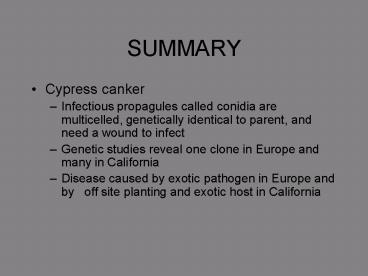SUMMARY - PowerPoint PPT Presentation
1 / 34
Title:
SUMMARY
Description:
... of an introduced species The entire genome was sequenced in less than 3 years since discovery of organism * 12 SSR ... of 1st microsatellite study ... – PowerPoint PPT presentation
Number of Views:50
Avg rating:3.0/5.0
Title: SUMMARY
1
SUMMARY
- Cypress canker
- Infectious propagules called conidia are
multicelled, genetically identical to parent, and
need a wound to infect - Genetic studies reveal one clone in Europe and
many in California - Disease caused by exotic pathogen in Europe and
by off site planting and exotic host in
California
2
Conidia of Seiridium cardinale observed by
optical microscope and SEM
3
SUMMARY
- Heterobasidion
- Primary infection caused by airborne genetically
distinct basidiospores - Secondary infection of adjacent trees caused by
direct root to root contact - Host specificity of H.irregulare vs. H.
occidentale - Stumps main infection courts for H. irregulare on
pine/juniper, wounds for true fir/sequoia - Environmental changes increase abundance of this
root and bole pathogen - Armillaria (Honey mushroom)
- Mostly secondary infection thanks to rhizomorphs,
largest organism in the world
4
True firs
Pines
Each spore is a genetically different
individual In pines we found the same genetic
individual in stumps and adjacent trees
indicating direct contagion between the two In
true firs and true firs/sequoias we find same
individual in adjacent standing trees indicating
infection not linked to stumps but to wounds on
standing trees
5
Emergent diseases3 exotic pathogens
- 99 of times human responsible for their
introduction
6
Like the conquistadores brought diseases that
were lethal to those who had never been exposed
to them, so do exotic diseases cause true
devastation in plant communities because of lack
of coevolution between hosts and microbes
7
California invaded 1849 A.D.
Port Orford Cedar Root Disease 1950s
New hybrid root pathogen 1990s
Manzanita/madrone die-back
Sudden Oak Death 1990s
White pine blister rust 1930s
Canker-stain of Sycamores 1980s
Dutch Elm Disease 1960s
Pitch canker disease 1980s
Oak root canker 2000
8
How can people transport pathogens
- By transporting plants and plant parts
- Crops, and seeds
- Raw food
- Ornamental plants
- Untreated lumber
- Soil
- Insects vectoring fungi
- Military activity
9
The Irish Potato Famine
- From 1845 to 1850
- Phytophthora infestans
- Resulted in the death of 750,000
- Emigration of over 2 million, mainly to the
United States.
10
(No Transcript)
11
Girdling aerial cankers removed from roots
12
Big Sur 2006 K. Frangioso
13
Wickland et al., unpublished
14
P. ramorum growing in a Petri dish
15
Organism new to science
- Origin unknown
- Biology unknown
- Symptoms caused unknown
- Immediately though highly regulated
16
Rhododendron In EU mostly a nursery issue, but
also present in nurseries in US and Canada
Stem canker
Leaf necrosis
17
Phytophthora ramorum
Sporangia
Chlamydospores
18
Is it exotic?
- Our studies have indicated that California
population is extremely simplified, basically two
strains reproducing clonally as expected of an
introduced organism - Many hosts appear to have no resistance at all
- Limited geographic distribution
19
Where does it come from?
- It is unknown where pathogen originally comes
from, but previous studies have shown that
California forest population is derived from a
relatively genetically diversified US nursery
population, indicating ornamental nurseries were
the most likely avenue for pathogen introduction
20
Lets look at its genetic structure
- Need a number of independent and neutral DNA
markers - Used AFLP, a technique that scans the entire
nuclear genome - Are our isolates the same as the European ones?
- Is the genetic structure suggestive of an
introduced or native species?
21
- US forest isolates clearly distinct from EU
nursery isolates, also have different mating type - Isolates from nurseries in WA, OR, BC both of
the US and EU types - Potential for XXX sex and recombination in US
nurseries - US forest population is genetically very
homogeneous, trademark of an introduced species
22
The entire genome was sequenced in less than 3
years since discovery of organism
12 SSR loci (di- and tri- repeats identified)
Loci selected to be polymorphic both between
and within continental populations 500
representative isolates analyzed
CCGAAATCGGACCTTGAGTGCGGAGAGAGAGAGAGACTGTACGAGCCCGA
GTCTCGCAT
23
Mating Type A1 A2 A2
Growth Rate Fast Slow Fast
24
Terminology Genotype Lineage Population
25
Results of 1st microsatellite study
- There actually three distinct (genotypically and
phenotypically) lineages of P. ramorum - Very low diversity in US forests (microsats
cannot discriminate among individuals, clonality
confirmed), only one lineage - Several genotypes but only one lineage in EU
nurseries - Three lineages in US nurseries
26
Was the pathogen first in US forests or in US
nurseries?
Slide 12
27
Was the pathogen first in US forests or in US
nurseries?
Slide 12
nurseries
forests
28
Where was it introduced?
- First reports mid 90s
- Pathogen identified in 2000
- By then, the pathogen was widespread
- CLUES severity of symptoms and anedoctal stories
29
We found same genotypes in nurseries and forests
proving origin of wild outbreak
30
Introduction phase 1- Escape of pathogen
from Infected nursery plants at two locations
Mount Tamalpais (Marin County), and
Scotts Valley (Santa Cruz County) 2- Nurseries
and two sites have identical strain composition,
but distance between sites is impossible for
natural spread of organism
31
What favors invasion of exotic fungi ?
- Density of host increases severity of disease
- Corridors linking natural habitats
- Synchronicity between host susceptibility and
pathogen life cycle - Ecological and environmental conditions
32
Bay/Oak association
Bay
Coast Live Oak (no sporulation)
Canker margin in phloem
Bleeding canker
Sporangia
33
(No Transcript)
34
Mantel test among all individuals. Morans I vs
ln (geographic distance)
Site ID Correlation coeff. (r) P-value (1000,000 perm)
ALL -0.2153 lt0.000001































